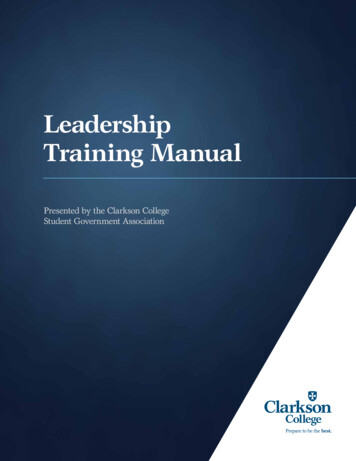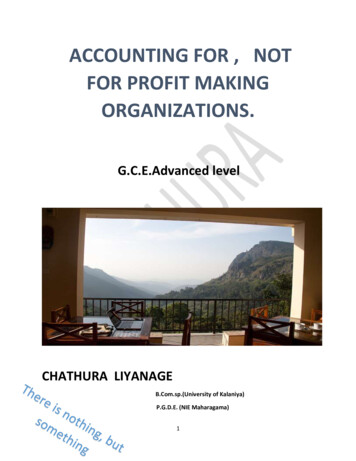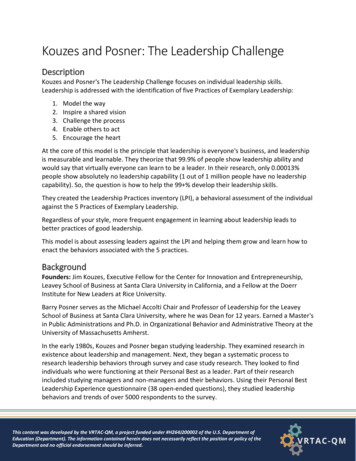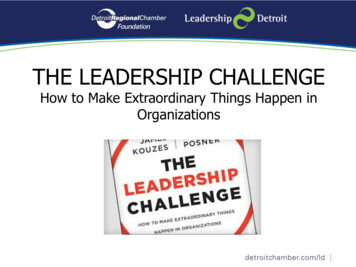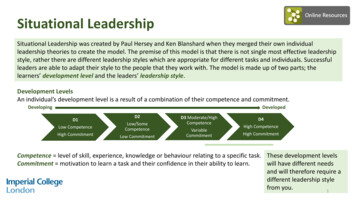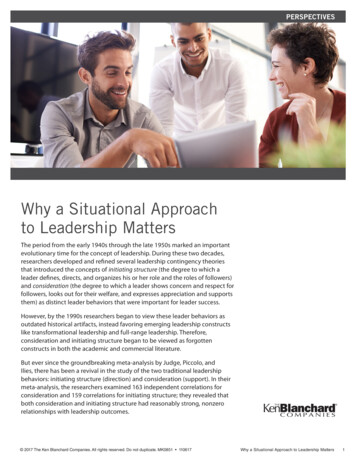
Transcription
Leadership inOrganizationsA01 YUKL5130 09 SE FM.indd 121/11/18 6:24 PM
A01 YUKL5130 09 SE FM.indd 221/11/18 6:24 PM
Ninth EditionLeadership inOrganizationsGary YuklState University of New Yorkat AlbanyWilliam L. Gardner, IIIRawls College of BusinessTexas Tech UniversityA01 YUKL5130 09 SE FM.indd 321/11/18 6:24 PM
Vice President, Business, Economics, and UKCourseware: Donna BattistaDirector of Portfolio Management: Stephanie WallSpecialist Portfolio Manager: Kris Ellis-LevyEditorial Assistant: Amanda McHughVice President, Product Marketing: Roxanne McCarleyProduct Marketer: Carlie MarvelProduct Marketing Assistant: Marianela SilvestriManager of Field Marketing, BusinessPublishing: Adam GoldsteinField Marketing Manager: Nicole PriceVice President, Production and Digital Studio, Artsand Business: Etain O’DeaDirector, Production and Digital Studio, Businessand Economics: Ashley SantoraManaging Producer, Business: Melissa FeimerSenior Content Producer: Claudia FernandesOperations Specialist: Carol MelvilleDesign Lead: Kathryn FootManager, Learning Tools: Brian SuretteLearning Tools Strategist: Michael TrinchettoManaging Producer, Digital Studio andGLP: James BatemanManaging Producer, Digital Studio: DianeLombardoDigital Studio Producer: Monique LawrenceDigital Studio Producer: Alana ColesFull Service Project Management: AllisonCampbell, Integra Software Services Pvt. Ltd.Interior Design: Integra Software Services Pvt. Ltd.Cover Design: Integra Software Services Pvt. Ltd.Cover Art: PA Images/Alamy Stock PhotoPrinter/Binder: LSC Communications, Inc./CrawfordsvilleCover Printer: Phoenix Color/HagerstownCopyright 2020, 2013, 2010 by Pearson Education, Inc. or its affiliates. All Rights Reserved.Manufactured in the United States of America. This publication is protected by copyright, and permission shouldbe obtained from the publisher prior to any prohibited reproduction, storage in a retrieval system, or transmissionin any form or by any means, electronic, mechanical, photocopying, recording, or otherwise. For informationregarding permissions, request forms, and the appropriate contacts within the Pearson Education Global Rightsand Permissions department, please visit www.pearsoned.com/permissions/.Acknowledgments of third-party content appear on the appropriate page within the text.PEARSON, ALWAYS LEARNING, and MYLAB are exclusive trademarks owned by Pearson Education, Inc. orits affiliates in the U.S. and/or other countries.Unless otherwise indicated herein, any third-party trademarks, logos, or icons that may appear in this work are theproperty of their respective owners, and any references to third-party trademarks, logos, icons, or other trade dressare for demonstrative or descriptive purposes only. Such references are not intended to imply any sponsorship,endorsement, authorization, or promotion of Pearson’s products by the owners of such marks, or any relationshipbetween the owner and Pearson Education, Inc., or its affiliates, authors, licensees, or distributors.Library of Congress Cataloging-in-Publication DataNames: Yukl, Gary A., author. Gardner, William L., III, author.Title: Leadership in organizations / Gary Yukl and William Gardner,University of Albany, State University of New York.Description: Ninth edition. Boston : Pearson Education, Inc., [2020] Includes bibliographical references and index.Identifiers: LCCN 2018041734 ISBN 9780134895130 ISBN 0134895134Subjects: LCSH: Leadership. Decision making. Organization.Classification: LCC HD57.7 .Y85 2020 DDC 658.4/092—dc23LC record available at https://lccn.loc.gov/2018041734119ISBN 10: 0-13-489513-4ISBN 13: 978-0-13-489513-0A01 YUKL5130 09 SE FM.indd 421/11/18 6:24 PM
For their support, devotion, and love, this book is dedicatedto Maureen and Claudia.A01 YUKL5130 09 SE FM.indd 521/11/18 6:24 PM
A01 YUKL5130 09 SE FM.indd 621/11/18 6:24 PM
BRIEF CONTENTSAbout the AuthorsPreface xviixvChapter 1Chapter 2Chapter 3Chapter 4Chapter 5Chapter 6Chapter 7Chapter 8Chapter 9Chapter 10Chapter 11Chapter 12Chapter 13Chapter 14Chapter 15The Nature of Leadership 1Leadership Behavior 22The Leadership Situation and Adaptive Leadership 46Decision Making and Empowerment by Leaders 72Leading Change and Innovation 106Power and Influence Tactics 138Leader Traits and Skills 172Charismatic and Transformational Leadership 203Values-Based and Ethical Leadership 230Dyadic Relations and Followers 255Leadership in Teams and Decision Groups 284Strategic Leadership in Organizations 315Cross-Cultural Leadership and Diversity 349Developing Leadership Skills 375Overview and Integration 402References 421Author Index 505Subject Index 526viiA01 YUKL5130 09 SE FM.indd 721/11/18 6:24 PM
A01 YUKL5130 09 SE FM.indd 821/11/18 6:24 PM
TABLE OF CONTENTSAbout the AuthorsPreface xviiCHAPTER 1xvTHE NATURE OF LEADERSHIPIntroduction1Definitions of Leadership2Indicators of Leadership Effectiveness8Research Methods for Studying Leadership Effectiveness10Major Perspectives in Leadership Theory and Research 11Level of Conceptualization for Leadership Theories 14Other Bases for Comparing Leadership Theories 18Organization of the Book 19Summary 20Review and Discussion Questions 21CHAPTER 2LEADERSHIP BEHAVIORIntroduction22Reasons for Diverse Taxonomies of Leadership Behavior 22Some Important Types of Leadership Behavior 23Specific Task-Oriented Leader Behaviors 26Specific Relations-Oriented Leader Behaviors 34Summary 42Review and Discussion Questions 43CASE: Consolidated Products 43CASE: Superior Staffing 45CHAPTER 3 THE LEADERSHIP SITUATION AND ADAPTIVELEADERSHIPIntroduction46Different Ways Situations Affect Leaders 46Stewart Model of Situational Determinants 47Other Situational Determinants of Leader Behavior 50Guidelines for Coping with Demands and Constraints 56Early Contingency Theories of Effective Leader Behavior 59ixA01 YUKL5130 09 SE FM.indd 921/11/18 6:24 PM
xTable of ContentsMultiple-Linkage Model 61Evaluation of Research on the Contingency Theories 65Guidelines for Flexible, Adaptive Leadership 66Summary 67Review and Discussion Questions 68CASE: Acme Manufacturing Company 69CASE: Foreign Auto Shop 70CHAPTER 4 DECISION MAKING AND EMPOWERMENTBY LEADERSIntroduction72Decision Making by Managers 73Participative Leadership 75Normative Decision Model 81Guidelines for Participative Leadership 85Delegation 89Guidelines for Delegating 93Psychological Empowerment 97Empowerment Programs 98Benefits of Empowering Leadership and Programs 100Summary 101Review and Discussion Questions 102CASE: Echo Electronics 103CASE: Alvis Corporation 104CHAPTER 5 LEADING CHANGE AND INNOVATIONIntroduction106Types of Change in Teams and Organizations 107Change Processes 108Reasons for Accepting or Rejecting Change 110Implementing Change 112Guidelines for Implementing Change 116How Visions Influence Change 121Collective Learning and Innovation 126Guidelines for Enhancing Learning and Innovation 130Summary 133Review and Discussion Questions 134CASE: Ultimate Office Products 135CASE: Ready Foods Company 136A01 YUKL5130 09 SE FM.indd 1021/11/18 6:24 PM
Table of ContentsCHAPTER 6xiPOWER AND INFLUENCE TACTICSIntroduction138Sources of Power 138How Power Is Gained or Lost 143Consequences of Power 145Guidelines for Using Power 147Influence Tactics and Outcomes 151Types of Proactive Influence Tactics 153Power and Influence Behavior 158Effectiveness of Proactive Tactics 159Guidelines for Using Proactive Influence Tactics 162Summary 167Review and Discussion QuestionsCASE: Sporting Goods Store 168CASE: The New Dean 170CHAPTER 7168LEADER TRAITS AND SKILLSIntroduction172Personality Traits and Effective Leadership 174Skills and Effective Leadership 185Managerial Competencies 189Situational Relevance of Traits and Skills 191Evaluation of the Trait Approach 195Guidelines for Leaders 196Summary 198Review and Discussion QuestionsCASE: National Products 199CASE: Prestige Marketing 201CHAPTER 8198CHARISMATIC AND TRANSFORMATIONAL LEADERSHIPIntroduction203Charismatic Leadership 204Effects of Charismatic Leaders 210Transformational Leadership 215Comparison of Charismatic and Transformational Leadership 217Evaluation of the Theories 219Guidelines for Inspirational Leadership 221A01 YUKL5130 09 SE FM.indd 1121/11/18 6:24 PM
xiiTable of ContentsSummary 224Review and Discussion Questions 225CASE: Metro Bank 225CASE: Astro Airlines Part 1 226CASE: Astro Airlines Part 2 227CHAPTER 9 VALUES-BASED AND ETHICAL LEADERSHIPIntroduction230Conceptions of Ethical Leadership 231Determinants and Consequences of Ethical Leadership 234Theories of Values-Based Leadership 239Comparison and Evaluation of Theories 245Guidelines for Ethical Leadership 248Summary 250Review and Discussion Questions 251CASE: Unethical Leadership at Enron 252CASE: Restview Hospital 253CHAPTER 10 DYADIC RELATIONS AND FOLLOWERSIntroduction255Leader–Member Exchange Theory 256Leader Attributions About Subordinates 261Guidelines for Correcting Performance Deficiencies 263Follower Attributions and Implicit Theories 267Impression Management by Leaders and ment 274Guidelines for Followers 276Summary 279Review and Discussion Questions 280CASE: Cromwell Electronics 281CASE: American Financial Corporation 282CHAPTER 11 LEADERSHIP IN TEAMS AND DECISION GROUPSIntroduction284Determinants of Team Performance 285Functional and Cross-Functional Work Teams 292Self-Managed Work Teams 297Guidelines for Leading Teams 300A01 YUKL5130 09 SE FM.indd 1221/11/18 6:24 PM
Table of ContentsxiiiLeading Decision Groups 303Guidelines for Leading Meetings 306Summary 310Review and Discussion Questions 311CASE: Southwest Engineering Services 311CASE: Columbia Corporation 313CHAPTER 12 STRATEGIC LEADERSHIP IN ORGANIZATIONSIntroduction315Determinants of Organizational Performance 316How Leaders Influence Organizational Performance 320Situations Affecting Strategic Leadership 324Organizational Culture 326Research on Effects of Strategic Leadership 329Executive Teams 332Other Conceptions of Organizational Leadership 335External Monitoring and Strategy Formulation 338Guidelines for Strategic Leadership 340Summary 343Review and Discussion QuestionsCASE: Costco 345CASE: Turnaround at Nissan 347344CHAPTER 13 CROSS-CULTURAL LEADERSHIP AND DIVERSITYIntroduction349Cross-Cultural and Global Leadership 349Cultural Values and Leadership 354Guidelines for Global Leadership 360Gender and Leadership 362Summary 371Review and Discussion Questions 372CASE: Madison, Jones, and Conklin 373CASE: A Day in the Life of a Global Leader374CHAPTER 14 DEVELOPING LEADERSHIP SKILLSIntroduction375Leadership Training Programs 376Learning from Experience 378Developmental Activities 380A01 YUKL5130 09 SE FM.indd 1321/11/18 6:24 PM
xivTable of ContentsFacilitating Leadership Development 391Systems Perspective on Leadership Development 394Summary 397Review and Discussion Questions 398CASE: Federated Industries 399CASE: River Bank 400CHAPTER 15 OVERVIEW AND INTEGRATIONIntroduction402Major Findings About Effective Leadership 403Multi-Level Explanatory Processes 407Ways to Improve Leadership Research 414General Guidelines for Effective Leadership 419The State of the Field 420Review and Discussion Questions 420References 421Author Index 505Subject Index 526A01 YUKL5130 09 SE FM.indd 1421/11/18 6:24 PM
ABOUT THE AUTHORSGary YuklAfter more than 45 years of studying leadership, Dr. Gary Yukl is highly qualified to write aboutthe subject. His highest academic degree is a Ph.D. in Industrial-Organizational Psychologyfrom the University of California, Berkeley. He is an emeritus professor at UAlbany, StateUniversity of New York, where before retiring he taught courses in leadership at the undergraduate, MBA, and doctoral level. He is a member of the editorial boards for several importantjournals that publish articles on leadership theory and research. His own publications includemany articles on leadership, and he has received a number of awards for best research article,most-cited article, and best convention paper. He has also received two lifetime achievementawards for his research and publications: the 2007 Walter Ulmer Applied Research Award fromthe Center for Creative Leadership, and the 2011 Eminent Leadership Scholar Award from theAcademy of Management Network of Leadership Scholars. He has consulted with severalbusiness and public-sector organizations to help improve the effectiveness of their managers,and the leadership development programs he designed for a consulting company were used bymanagers and administrators in many organizations. Some of the practical guidelines presentedin this book are from management development programs found to improve the effectiveness ofthe participants. For his exceptional research and scholarship he was elected a Fellow of theAmerican Psychological Association, the American Psychological Society, the Society forIndustrial-Organizational Psychology, and the Academy of Management.William L. Gardner, IIIDrawing on his 40-plus years of teaching and researching leadership, Dr. William (Bill) Gardneris well positioned to share his insights on leaders and effective leadership. His highest academicdegree is a Doctor of Business Administration (DBA) from Florida State University. He holdsthe Jerry S. Rawls Chair in Leadership and serves as the Director of the Institute for LeadershipResearch in the Rawls College of Business at Texas Tech University. He previously held faculty positions at Southern Illinois University, the University of Mississippi, and the Universityof Nebraska–Lincoln. During his career, he has taught leadership and management courses atthe undergraduate, masters, professional MBA, and doctoral levels. Currently, he serves as theEditor-in-Chief for Group & Organization Management and as an Associate Editor for TheLeadership Quarterly. He has published numerous high-impact articles focused on leadershipin top-tier journals and received several best-paper and most-cited-article awards. In 2011, hereceived the Distinguished Doctoral Alumni Award from the College of Business at FloridaState University. In 2015, Texas Tech recognized him as an “Integrated Scholar,” an honor bestowed to “a faculty member who not only demonstrates outstanding teaching, research, andservice, but is able to generate synergy among the three functions.” In recognition of his extensive contributors to the Southern Management Association (SMA), including his service asPresident and an SMA Fellow, he received the “James G. (Jerry) Hunt Sustained OutstandingService Award” in 2017.xvA01 YUKL5130 09 SE FM.indd 1521/11/18 6:24 PM
A01 YUKL5130 09 SE FM.indd 1621/11/18 6:24 PM
PREFACEThis book is about leadership in organizations. Its primary focus is on managerial l eadershipas opposed to parliamentary leadership, leadership in social movements, or emergent leadership ininformal groups. The book presents a broad survey of theory and research on leadership in formalorganizations. Topics of special interest are the determinants of leadership effectiveness and howleadership can be improved. William Gardner was added as a second author for this edition toincorporate his knowledge and perspective on effective leadership.The book is appropriate for use as the primary text in an undergraduate or graduate course inleadership. Such courses are found in many different schools or departments, including business,psychology, sociology, educational administration, public administration, and health-care administration. The book is on the list of required or recommended readings for students in many doctoralprograms in leadership, management, and industrial-organizational psychology. With its focus oneffective leadership in organizations, the book is especially relevant for students who expect to become a manager or administrator in the near future, for people who will be responsible for training orcoaching leaders, and for people who will be teaching courses or workshops that include leadershipas one of the key topics. The book is also useful for practicing managers and consultants who arelooking for something more than vague theories and superficial answers to difficult questions aboutleadership. The book is widely used in many different countries, and some editions were translatedinto other languages, including Chinese, Korean, Indonesian, Spanish, Greek, Croatian, and Swedish.The content of the book still reflects a dual concern for theory and practice. We haveattempted to satisfy two different audiences with somewhat different perspectives. Most academics prefer a book that explains and evaluates major theories and relevant empirical research. They are most interested in how well the research was done, what was found, how wellthe research supports the theoretical basis for it, and what additional research is needed. Academicstend to be skeptical about the value of prescriptions and guidelines for practitioners and mayconsider them premature in the absence of further research. In contrast, most practitioners wantsome immediate answers about what to do and how to do it in order to be more effective as leaders. They need to deal with the current challenges of their job and cannot wait for decades untilthe academics resolve their theoretical disputes and obtain definitive answers. Practitioners aremore interested in finding helpful remedies and prescriptions than in finding out how thisknowledge was discovered. Readers who desire to improve their leadership effectiveness willfind this edition of the book is even more useful than previous editions.The different preferences are one of the reasons for the much-lamented gulf betweenscientists and practitioners in management and industrial-organizational psychology. We believe it is important for managers and administrators to understand the complexity of effectiveleadership, the source of our knowledge about leadership in organizations, and the limitationsof this knowledge. Likewise, we believe it is important for academics to think more about howtheir theories and research can be used to improve the practice of management. Too much ofour leadership research is designed to examine narrow, esoteric questions that only interest afew other scholars who publish in the same journals.Academics will be pleased to find that major theories are explained and evaluated, findings in empirical research on leadership are summarized, and many references are provided tohelp readers find sources of additional information about topics of special interest. The field ofleadership is still in a state of ferment, with many continuing controversies about conceptualxviiA01 YUKL5130 09 SE FM.indd 1721/11/18 6:24 PM
xviiiPrefaceand methodological issues. The book addresses these issues, but the literature review was notintended to be comprehensive. Rather than detailing an endless series of weak theories and inconclusive studies like most handbooks of leadership, this book describes major findings abouteffective leadership and how they can be applied by readers.For practitioners and students who desire to become effective managers, we attempted toconvey a better appreciation of the complexity of managerial leadership, the importance of having theoretical knowledge about leadership, and the need to be flexible and pragmatic in applying this knowledge. The current edition provides many guidelines and recommendations forimproving managerial effectiveness, but it is not a “practitioner’s manual” of simple techniquesand secret recipes that guarantee instant success. The purpose of the guidelines is to help thereader understand the practical implications of the leadership theory and research, not to prescribe exactly how things must be done by a leader. Most of the guidelines are based on a limitedamount of research and they are not infallible or relevant for all situations. Being a flexible, adaptive leader includes determining which guidelines are relevant for each unique situation.Most chapters end with two short cases designed to help the reader gain a better understanding of the theories, concepts, and guidelines presented in the chapter. Most of the cases describeevents that occurred in real organizations, but some cases were modified to make them more usefulfor learning basic concepts and effective practices. For many of the cases, the names of organizations and individuals were changed to keep the analysis focused on the events that occurred in adefined time period, rather than on recent events that may involve different leaders and a differentsituation. The cases ask a reader to analyze behavioral processes, identify examples of effectiveand ineffective behavior, and suggest effective ways to handle the situation that is depicted.In this ninth edition, the basic structure of most chapters remains the same, but the orderof some chapters was changed, a few topics were moved to a different chapter, some new topics were added, and the discussion of some other topics was expanded. Since the book is notintended to be a history of leadership, it seemed appropriate to reduce the amount of detailabout early research programs and old theories that are no longer popular, and focus moreclosely on what we now know about effective leadership.New to This EditionFollowing is a list of changes we made to make the book easier to understand and more usefulto most readers: The number of chapters was reduced from 16 to 15 to improve the organization of content.The order of chapters was modified to improve the explanation of related topics.Every chapter has been updated and revised for clarity and understanding.New examples of effective and ineffective leadership were added to most chapters.Personal Reflection exercises were added to most chapters to help students think criticallyand apply the leadership concepts. Several new cases were added, and there are now two cases for all but the introductionand overview chapters. Over 500 citations to recent research were added throughout. The design of the book was updated, and two colors are used for this edition.Chapter by Chapter Changes In Chapter 1 (The Nature of Leadership) we added a discussion of the research methodsused to study leadership, including new methods such as social networks, biosensorA01 YUKL5130 09 SE FM.indd 1821/11/18 6:24 PM
Preface xixmethods, and behavioral genetics. The description of different theoretical approachesfor studying leadership was expanded.In Chapter 2 (Leadership Behavior) the description of distinct types of leadership behavior was revised to include new knowledge and theories about these subjects. A new caseon leadership behavior was added to the chapter.In Chapter 3 (The Leadership Situation and Adaptive Leadership) the ways in whichleaders are influenced by the leadership situation was expanded to include the discussion of leadership in extreme situations such as hospital emergency rooms, SWAT teams,and police work. This chapter also includes some theories of situational determinantsand adaptive leadership that were included in a separate chapter on managerial work inthe previous edition.In Chapter 4 (Decision Making and Empowerment by Leaders) we added a discussion ofthe threshold effect of participative leadership, which explains how there is a minimumlevel of participative leadership that must be reached before the positive effects onemployee performance are realized. In addition, we expanded the discussion of psychological empowerment and empowering leadership.In Chapter 5 (Leading Change and Innovation) we added a discussion of the differencesamong developmental, transitional, and transformational change, and organizationalcynicism about change was added as another reason for rejecting change. A discussionof the strategic fitness process is included, and it involves a nine-step process of organizational change that combats the “silent killers” of organizational effectiveness. Thischapter also includes a new case about leading change.In Chapter 6 (Power and Influence Tactics) the description of how leaders can effectively use their power and several different influence tactics was expanded. A new caseabout power and influence was added to the chapter.In Chapter 7 (Leader Traits and Skills) we added a discussion of core self-evaluations about aleader’s worthiness, effectiveness, and capacity as a person. In addition, the concept of politicalskill is discussed in more detail, along with the associated research and practical implications ofthis skill.In Chapter 8 (Charismatic and Transformational Leadership) we added a discussion ofspecific charismatic leadership tactics that leaders use to manage impressions. We alsodescribe how leaders can learn to effectively use these tactics. The discussion of contextual factors that contribute to the emergence and impact of charismatic leadership wasexpanded to include attributional ambiguity.In Chapter 9 (Value-Based and Ethical Leadership) we added an explanation of the factors that increase the moral intensity of an ethical issue and the effects of moral intensityon ethical leadership. The constructs of ethical culture and ethical climate, and the differences between them, are discussed, along with their effects on leader and followerbehaviors in organizations. We also refined the discussion of authentic leadership bydescribing the four components: self-awareness, balanced processing, relational transparency, and an internalized moral perspective.In Chapter 10 (Dyadic Relations and Followership) we added a discussion of how aleader’s affective expressions serve as cues about the leader’s enthusiasm for the relationship, which in turn evoke emotional reactions from followers. We also describe howleaders and followers sometimes attribute performance problems to their relationshiprather than to internal or external causes, and how leaders and followers may engage inrelational work for the purpose of improving the relationship and future performance.A01 YUKL5130 09 SE FM.indd 1921/11/18 6:24 PM
xxPreface In Chapter 11 (Leadership in Teams and Decision Groups) we added a discussion ofhow a team’s composition affects the emergence of identity-based, resource-based,and knowledge-based subgroups, and the implications of these subgroups are explained. A new case was also added to this chapter. In Chapter 12 (Strategic Leadership in Organizations) we added a detailed discussion ofstrategic human resource management, which calls for an alignment and coordination ofthe firm’s human resource practices across organizational levels to ensure that humancapital is deployed strategically to foster enhanced competitiveness. In Chapter 13 (Cross-Cultural Leadership and Diversity) we introduced the concept ofglobal leadership and added a set of guidelines for effective global leadership and thepractical challenges that confront leaders of multinational organizations. We also addeda discussion of the “glass cliff” phenomenon, which refers to the tendency of women tobe more likely to be appointed to leadership positions that are risky and precarious.We included a discussion of findings from research that investigates the relationshipsbetween gender composition on corporate boards and key organizational outcomes.A new case was also added to this chapter. In Chapter 14 (Developing Leadership Skills) we added a discussion of how return ondevelopment investment (RODI) can be used as a metric for assessing the impact ofleadership development programs and activities. In addition, we expanded the description of factors that facilitate leader development to include the concept of developmentalreadiness, which is a function of the leader’s ability and motivation to develop. We alsoadded a new case to this chapter. In Chapter 15 (Overview and Integration) we updated the summary of major findingsabout effective leadership to include new findings since the eighth edition was written.Ways to improve leadership research in the future are suggested, and we briefly summarize some general guidelines for effective leadership.Gary YuklThe Villages, FloridaWilliam L. GardnerLubbock, TexasAugust, 2018Instructor Resource CenterAt Pearson’s Higher Ed catalog, https://www.pearsonhighered.com/sign-in.html, instructors caneasily register to gain access to a variety of instructor resources available with this text in downloadable format. If assistance is needed, our dedicated technical support team is ready to helpwith the media supplements that accompany this text. Visit https://support.pearson.com/getsupportfor answers to frequently asked questions and toll-free user support phone numbers.The following supplements are available with this text: Instructor’s Resource ManualTest BankTestGen Computerized Test BankPowerPoint PresentationThis title is available as an eBook and can be purchased at most eBook retailers.A01 YUKL5130 09 SE FM.indd 2021/11/18 6:24 PM
Rawls College of Business Texas Tech University Ninth Edition A01_YUKL5130_09_SE_FM.indd 3 21/11/18 6:24 PM. . Chapter 4 Decision Making and Empowerment by Leaders 72 . Chapter 9 Values-Based and Ethical Leadership 230 Chapter 10 Dyadic Relations and Followers 255 Chapter 11 Lea
